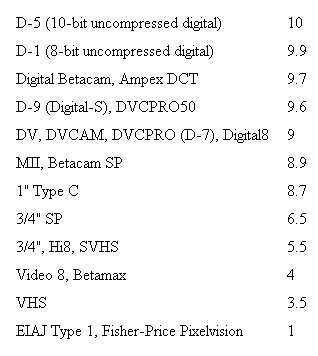There are several method for preserving video. This website makes a distinction between traditional methods and digital methods. Digital methods are considered superior because the video is digitized using a format that is far superior to any previous analog or digital videotape format; see the ITU-BT 601 and BT 709 in the attached list of analog and digital video formats. All copies of the digital file, saved on a hard drive (HD) will be perfect; just as all digital files are perfect copies.
The tradition method of migration is to copy the historic videotape onto a new videotape. This will extend the life of historic videotape, but image quality will be lost because signal remains analog. When that remastered analog original (master) is copied to make a archival sub-master or a use copy the succeeding, generations will suffer image loss because the signal is still analog.
The following is a list of video migration possibilities:
In the following list, the current videotape formats are ranked, based on the experience of a group of video technical folks. The point is that the historic formats U-Matic, VHS, S-VHS and Betamax are ranked against their possible replacements. |
|
The tradition method calls for a group of videotapes to be packaged and shipped to a video service bureau. In the Bay Area and Los Angles, this is simple because there are many such service bureaus, but outside of major cities the process is more complex. The problem is that the owner looses control of their cultural artifacts, to organizations that don't have the same respect for artifacts such as Conservators or Art Shippers. In addition, the cost ranges from $200-400.
Because a nameless service bureau technician handles the tapes and makes critical selections such as (a) cleaning, (b) number of passes, (c) signal compression, (d) noise reduction and (e) the final appearance of the video output, the curator or archivist losses physical and intellectual control of the art work or historic artifact. The format(s) for migration is chosen and the tape is migrated. Most service bureaus also clean every tape they migrate. The cleaning process
|

